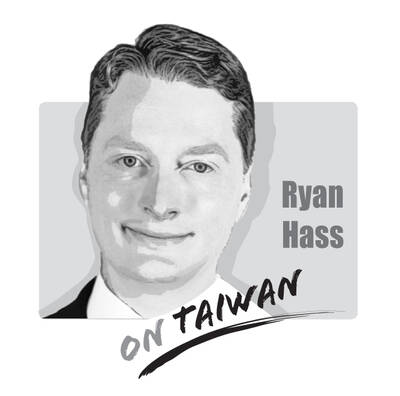In 2016, during the first six months of President Tsai Ing-wen’s (蔡英文) first term, the media were reporting how Taiwan Semiconductor Manufacturing Co (TSMC) might build a new US fab to produce 3-nanometer chips due to concern over water and electricity shortages in Taiwan.
On July 20 of that year, I was assigned to serve in Taiwan Water Corp (TWC), where I was part of discussions on Taiwan’s reservoirs.
I discovered that the highest usage rate for the Feicui Reservoir (翡翠水庫) in New Taipei City’s Shihding District (石碇) over its 30-year existence was 49.97 percent in 2003. This shows that northern Taiwan has plenty of water resources that could be transferred southward.
Every year, half or more of the water in the Feicui Reservoir flows out via electricity generation or controlled discharge to prevent it from overflowing. It is a shame that the water cannot be used more effectively.
The Shihmen Reservoir (石門水庫) in Taoyuan supplies nearly 1 million tonnes of water per day locally, as well as to New Taipei City. We estimated that if New Taipei City were to draw all its water from the Feicui Reservoir during an extremely dry period, water from the Shihmen Reservoir could be transferred southward to Hsinchu county and city.
On Dec. 23, 2016, I went with TWC colleagues to visit then-TSMC chairman Morris Chang (張忠謀) to discuss two main points:
First, Tainan had water sources that could adequately meet the requirements of a TSMC fab at the Southern Taiwan Science Park, but the water rights belonged to the Chianan Irrigation Association, not to TWC. It was possible to transfer enough water from the Zengwen Reservoir (曾文水庫) in Chiayi County to provide for household and commercial use, including agriculture and industry.
Second, the water supply in Hsinchu county and city depended mostly on the Toucian River (頭前溪), the Baoshan Reservoir (寶山水庫) and the Baoshan Second Reservoir (寶二水庫), whose supplies of water are at risk during extreme weather.
I told Chang that TWC would help to relieve Hsinchu’s water shortage crisis by building a pipeline that could deliver 200,000 tonnes of treated water per day from the Shihmen Reservoir to Hsinchu, and that this would likely mitigate Hsinchu’s water shortage risk.
In June 2017, Tsai visited the Hsinchu Science Park to hear the opinions of Chang, MediaTek chairman Tsai Ming-kai (蔡明介) and other senior figures in the industry. Then-Allied Association for Science Park Industries chairman David Shen (沈國榮) told us of the need to focus on the risk of water shortages.
In September of that year, William Lai (賴清德), after he became premier, summoned us to the Executive Yuan four times to talk about how to solve the water shortage crisis.
After getting a full understanding of the situation, Lai decided that the government’s Forward-looking Infrastructure Development Program should include the NT$2.8 billion (US$98.84 million at the current exchange rate) pipeline, which would carry tap water from Taoyuan to Hsinchu.
Earlier this month — following many years of surveys, plans and construction — Tsai, Premier Su Tseng-chang (蘇貞昌), Taoyuan Mayor Cheng Wen-tsan (鄭文燦), Hsinchu Mayor Lin Chih-chien (林智堅) and Hsinchu County Commissioner Yang Wen-ke (楊文科) gathered to switch on the pipeline.
Hopefully the daily supply of 200,000 tonnes of water can get Hsinchu County, Hsinchu City and the Hsinchu Science Park safely through the driest period in 100 years.
Kuo Chun-ming is chairman of the Chinese Taiwan Water Works Association and a former chairman of Taiwan Water Corp.
Translated by Julian Clegg

US President Donald Trump has gotten off to a head-spinning start in his foreign policy. He has pressured Denmark to cede Greenland to the United States, threatened to take over the Panama Canal, urged Canada to become the 51st US state, unilaterally renamed the Gulf of Mexico to “the Gulf of America” and announced plans for the United States to annex and administer Gaza. He has imposed and then suspended 25 percent tariffs on Canada and Mexico for their roles in the flow of fentanyl into the United States, while at the same time increasing tariffs on China by 10

Trying to force a partnership between Taiwan Semiconductor Manufacturing Co (TSMC) and Intel Corp would be a wildly complex ordeal. Already, the reported request from the Trump administration for TSMC to take a controlling stake in Intel’s US factories is facing valid questions about feasibility from all sides. Washington would likely not support a foreign company operating Intel’s domestic factories, Reuters reported — just look at how that is going over in the steel sector. Meanwhile, many in Taiwan are concerned about the company being forced to transfer its bleeding-edge tech capabilities and give up its strategic advantage. This is especially
US President Donald Trump last week announced plans to impose reciprocal tariffs on eight countries. As Taiwan, a key hub for semiconductor manufacturing, is among them, the policy would significantly affect the country. In response, Minister of Economic Affairs J.W. Kuo (郭智輝) dispatched two officials to the US for negotiations, and Taiwan Semiconductor Manufacturing Co’s (TSMC) board of directors convened its first-ever meeting in the US. Those developments highlight how the US’ unstable trade policies are posing a growing threat to Taiwan. Can the US truly gain an advantage in chip manufacturing by reversing trade liberalization? Is it realistic to
Last week, 24 Republican representatives in the US Congress proposed a resolution calling for US President Donald Trump’s administration to abandon the US’ “one China” policy, calling it outdated, counterproductive and not reflective of reality, and to restore official diplomatic relations with Taiwan, enter bilateral free-trade agreement negotiations and support its entry into international organizations. That is an exciting and inspiring development. To help the US government and other nations further understand that Taiwan is not a part of China, that those “one China” policies are contrary to the fact that the two countries across the Taiwan Strait are independent and